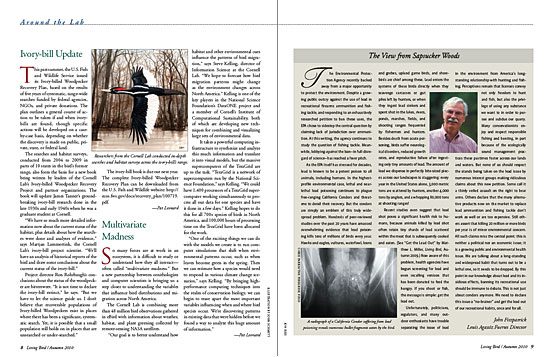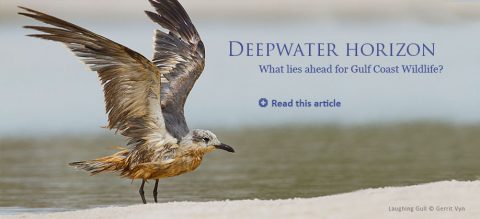View From Sapsucker Woods: EPA Sidesteps Lead Ammunition Ban
by John Fitzpatrick
October 15, 2010
The Environmental Protection Agency recently backed away from a major opportunity to protect the environment. Despite a growing public outcry against the use of lead in recreational firearms ammunition and fishing tackle, and responding to an exhaustively researched petition to ban these uses, the EPA chose to sidestep the central question by claiming lack of jurisdiction over ammunition. At this writing, the agency continues to study the question of fishing tackle. Meanwhile, lobbying against the ban—in full disregard of science—has reached a fever pitch.
As the EPA itself has stressed for decades, lead is known to be a potent poison to all animals, including humans. In the highest-profile environmental case, lethal and near-lethal lead poisoning continues to plague free-ranging California Condors and threatens to derail their recovery. But the condors are simply an emblem of this truly widespread problem. Hundreds of peer-reviewed studies over the past 20 years have amassed overwhelming evidence that lead poisoning kills tens of millions of birds every year. Hawks and eagles, vultures, waterfowl, loons and grebes, upland game birds, and shorebirds are chief among these. Lead enters the systems of these birds directly when they scavenge carcasses or gut piles left by hunters, or when they ingest lead sinkers and spent shot in the lakes, rivers, ponds, marshes, fields, and shooting ranges frequented by fishermen and hunters. Besides death from acute poisoning, birds suffer neurological disorders, reduced growth rates, and reproductive failure after ingesting only tiny amounts of lead. The amount of lead we dispense in perfectly bite-sized pieces across our landscapes is staggering: every year in the United States alone, 3,000 metric tons are scattered by hunters, another 4,000 tons by anglers, and a whopping 80,000 tons at shooting ranges!
Recent studies even suggest that lead shot poses a significant health risk to humans, because animals killed by lead shot often retain tiny shards of lead scattered within the meat that is subsequently cooked and eaten. (See “Get the Lead Out” by Matthew L. Miller, Living Bird, Autumn 2009.) Now aware of this problem, health agencies have begun screening for lead and even recalling venison that has been donated to feed the hungry. If you shoot or fish, the message is simple: get the lead out.
Unfortunately, politicians, regulators, and many outdoor enthusiasts have trouble separating the issue of lead in the environment from America’s longstanding relationship with hunting and fishing. Perceptions remain that licenses convey not only freedom to hunt and fish, but also the privilege of using any substance we want to in order to pursue and subdue our quarry. Many conservationists enjoy and respect responsible fishing and hunting, in part because of the ecologically sound management practices these pastimes foster across our lands and waters. But none of us should respect the stands being taken on the lead issue by numerous interest groups making ridiculous claims about this new petition. Some call it a thinly veiled assault on the right to bear arms. Others declare that the many alternative products now on the market to replace lead ammunition and fishing tackle don’t work as well or are too expensive. Still others assert that killing 20 million or more birds per year is of minor environmental concern. All such claims miss the central point: this is neither a political nor an economic issue; it is a growing public and environmental health issue. We are talking about a long-standing and widespread habit that turns out to be a lethal one, so it needs to be dropped. By this point in our knowledge about lead and its insidious effects, banning its recreational use should be immune to debate. This is not just about condors anymore. We need to declare this issue a “no-brainer” and get the lead out of our recreational habits, once and for all.

All About Birds
is a free resource
Available for everyone,
funded by donors like you
American Kestrel by Blair Dudeck / Macaulay Library



